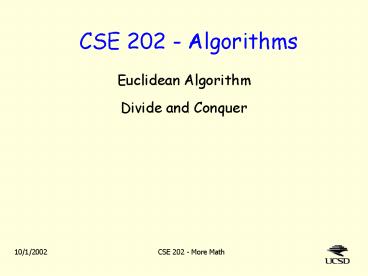CSE 202 - Algorithms PowerPoint PPT Presentation
Title: CSE 202 - Algorithms
1
CSE 202 - Algorithms
- Euclidean Algorithm
- Divide and Conquer
2
Euclidean Algorithm
- GCD stands for greatest common divisor.
- E.g. GCD(10, 25) 5. If GCD(A,B)1, we say A
and B are relatively prime. - Note that GCD(N, 0) N. (At least for Ngt0.)
- Thm If A kB C and B?0, then GCD(A,B)
GCD(B,C). - Proof. Let g GCD(A,B) and h GCD(B,C).
- Since g divides A and B, it must divide A kB
C. - Since g is a common divisor of B and C, it must
be ? their greatest common divisor, i.e. g ? h. - Reversing the roles of A and C, we conclude that
h ? g. - Thus, g h. QED
- The Euclidean Algorithm finds GCD(A,B).
- Given A gt B gt 0, set C A mod B (so C A - kB
for some k and CltB). - This reduces the problem of finding GCD(A,B)
to the smaller problem, finding GCD(B,C).
Eventually, well get to GCD(X,0) X.
3
Euclidean Algorithm
- Example Find GCD of 38 and 10.
- 38 mod 10 8
- 10 mod 8 2
- 8 mod 2 0
- GCD(2,0) 2
4
Euclidean Algorithm
Extended
- Example Find GCD of 38 and 10.
- 38 mod 10 8
- 10 mod 8 2
- 8 mod 2 0
- GCD(2,0) 2
- Can write 2 as linear combination of 10 and 38.
Lets you write 8 in terms of 38 and 10
8 38 - 3x10 2 10 1x8 10
1x(383x10) 2 4x10 1x38
Lets you write 2 in terms of 10 and 8.
Change 8s to 10s and 38s
Voila!
5
Euclidean Magic
Linear equations over integers
- Solve Diophantine Equations
- E.g. Write 6 as an integer combination of 38 and
10 - First write GCD(38,10) as a combination (2
4x10 1x38), then multiply by 6/GCD 3
(6 12x10 3x38). - Rational approximations
- E.g. 31416 3x10000 1416
- 10000 7x1416 88
- Lets pretend 88 ? 0. We then have 1416 ? 10000/7
- Thus, 31416 ? 3x10000 10000/7
10000x(31/7) - Thus, 3.1416 ? 31/7 22/7 ( 3.142857...)
- We can get all close approximations this way.
6
Morals
- Once you have solved something (e.g. GCD), see if
you can solve other problems (e.g. linear integer
equations, approximations, ...) - Ive shown some the key ideas without writing out
the algorithms they are actually simple. - Continued fractions does this all nicely!
- If this is your idea of fun, try cryptography.
7
Divide Conquer
- Basic Idea
- Break big problem into subproblems
- Solve each subproblem
- Directly if its very small
- Otherwise recursively break it up, etc.
- Combine these solutions to solve big problem
8
Faster Multiplication ??
- Standard method for multiplying long numbers
- (1000ab)x(1000cd) 1,000,000 ac
- 1000
(ad bc) -
bd - Clever trick
- (1000ab)x(1000cd) 1,000,000 ac
- 1000 (
(ab)(cd) ac - bd) - bd
- One length-k multiply 3 length-k/2 multiplies
and a bunch of additions and shifting. - On computer, might use 216 in place of 1000
- Fine print If ab has 17 bits, drop the top
bit, but add extra cd in the right place. Handle
overflow for cd similarly.
4 multiplies ac, ad, bc, bd
3 multiplies ac, (ab)(cd), bd
9
Faster Multiplication !!
- To magnify savings, use recursion (Divide
Conquer). - Let T(n) time to multiply two n-chunk numbers.
- For n even, we have T(n) lt 3T(n/2) c n
- This is called a recurrence equation
- Make c big enough so that cn time lets you do all
the adds, subtracts, shifts, handling carry bits,
and dealing with /-. - Reasonable, since operations are on n-chunk
numbers. - Recursively divide until we have 1-chunk numbers
- Need lg n divide steps.
- Also make c big enough so T(1) lt c.
10
Recursion Tree
c n
1 depth-0 node
3 depth-1 nodes
c n/2
c n/2
c n/2
...
9 depth-2 nodes
c n/4
c n/4
c n/4
c n/4
c n/4
...
...
...
...
...
3lg n depth-lg n nodes
c
c
c
11
From the picture, we know ...
- T(n) lt cn ( 1 3(1/2) 9(1/4) ... 3lg n(1/
2lg n) ) - lt cn ( 1 3/2 (3/2)2 ... (3/2)lg n ).
- Lemma 1 For a ?1, ak ak-1 ... 1 (ak1 1)
/ (a-1) - Proof (ak ak-1 ... 1) (a-1) ak1 -
1 - Its obvious! (Multiply it out
middle terms cancel.) - By lemma 1, T(n) lt cn ( (3/2)(lg n 1) 1) /
((3/2)-1) - lt cn ( (3/2)lg n
(3/2) 0) / (1/2) - c n
(3/2)lg n (3/2)/(1/2) - 3 c n
(3/2)lg n .
12
And finally ...
- Lemma 2 a lg b b lg a
- Proof alg b (2lg a)lg b 2lg a lg b (2lg
b)lg a blg a - Applying Lemma 2, we have
- T(n) lt 3cn (3/2)lg n 3cn (nlg(3/2)) 3c
n1lg(3/2). - Thus, T(n) ? O(n1lg(3/2)) O ( n1.58...).
13
Key points
- Divide Conquer can magnify a small advantage.
- Recursion tree gives method of solving recurrence
equations. - Well look at other methods next.
- Lemmas 1 and 2 are useful.
- Make sure youre comfortable with the math.

